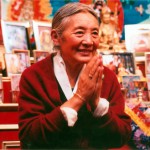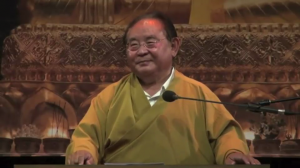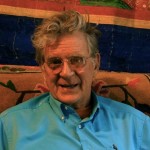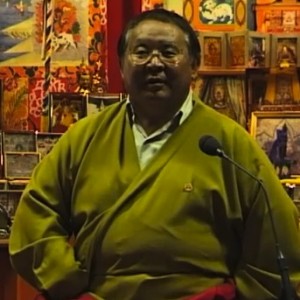Remembering Khandro Tsering Chödrön
It is now two years since Khandro Tsering Chödrön, the great dakini [female embodiment of enlightened energy] and accomplished practitioner, passed away. The embodiment of utter simplicity and unflagging faith and devotion, she was an inspiration to all who met her whether in the East or in the West, where she spent the last years of her life at Sogyal Rinpoche’s main retreat centre in the south of France.
For the newest post to our series Remembering the Masters, we’re pleased to share this beautiful short video commemorating her exemplary life.
Here is a passage of Sogyal Rinpoche’s unforgettable recollection of her in Chapter 9 of The Tibetan Book of Living and Dying:
In a figure like Khandro Tsering Chödrön, the greatest woman master of our day, who was the wife of my master Jamyang Khyentse, you see very clearly what years of the deepest devotion and practice can create out of the human spirit. Her humility and beauty of heart, and the shining simplicity, modesty, and lucid, tender wisdom of her presence are honored by all Tibetans, even though she herself tried as far as possible to remain in the background, never to push herself forward, and to live the hidden and austere life of an ancient contemplative.
Jamyang Khyentse was the inspiration of Khandro’s entire life. It was her spiritual marriage to him that transformed her from a very beautiful and slightly rebellious young woman into the radiant dakini that other great masters hold in the highest regard. Dilgo Khyentse Rinpoche looked to her as a “spiritual mother,” and always used to say how privileged he felt that of all the Lamas she revered and loved him most deeply. Whenever he used to see Khandro, he would take her hand and tenderly caress it, and then slowly place it on his head; he knew that was the only way he could ever get Khandro to bless him.
Jamyang Khyentse gave Khandro all the teachings, and trained her and inspired her to practice. Her questions to him would be in the form of songs, and he would write songs back to her, in an almost teasing and playful way. Khandro demonstrated her undying devotion to her master by continuing to live after his death in the place in Sikkim where he lived toward the end of his life, where he died, and where his relics are kept, enshrined in a stupa. There, near him, she carried on her clear, independent life, devoted to constant prayer. She read the whole Word of the Buddha and hundreds of volumes of commentaries, slowly, word by word. Dilgo Khyentse Rinpoche used to say that every time he went back to the stupa of Jamyang Khyentse, he felt as if he were coming home, because Khandro’s presence made the atmosphere so rich and warm. It was as if, he implied, my master Jamyang Khyentse was still present and still alive, in her devotion and her being.
For more videos in the series Remembering the Masters see the following posts:
Memories of Jamyang Khyentse Chökyi Lodrö
For more about Khandro Tsering Chödrön, see In Memory of Khandro Tsering Chödrön and her entry on the Rigpawiki.
The Essence of the Buddha’s Teaching
During his recent teaching tour in Australia, Sogyal Rinpoche, author of The Tibetan Book of Living and Dying, gave an inspired series of public talks in Sydney and Melbourne.
In this first extract from a talk in Sydney, Rinpoche shares a teaching on the importance of discovering inner peace and contentment––what the Buddha called “the most excellent wealth”––which is in part based on a message from His Holiness the Dalai Lama.
Though the teachings of the Buddha are vast, and number more than a hundred volumes, Rinpoche explains how they can all be summed up into these four simple lines:
Commit not a single unwholesome action,
Cultivate a wealth of virtue,
And to tame this mind of ours,
This is the teaching of the Buddha.
Other selections from this teaching will appear soon.
For more teachings and information on Sogyal Rinpoche’s schedule, don’t forget to keep checking SogyalRinpoche.org.
Robert Thurman: Sogyal Rinpoche and The Tibetan Book of Living & Dying
In an Interview, Robert Thurman Shares his thoughts on the Impact of Sogyal Rinpoche’s The Tibetan Book of Living and Dying:
“Dealing with the terrible difficulties of dying or having a relative or loved one die is a really hard thing. And in our culture we don’t do it well.
But we’re doing it better now thanks to Sogyal Rinpoche’s great book, The Tibetan Book of Living and Dying, and also thanks to the better knowledge that people are getting from The Tibetan Book of the Dead from my own work and the work of many others. Much of the improvement is also thanks to the work of some of Rinpoche’s students, such as Christine Longaker, who have gotten very involved in the hospice movement.
We all owe Sogyal Rinpoche such as huge debt of gratitude. He has done so much great work, for example in bringing His Holiness the Dalai Lama to Europe again and again. Not to mention the wonderful retreat centre in Lerab Ling, as well as the many wonderful students whose lives he’s helped and touched.
Running down the centre of all of this is his wonderful book, which is still massively popular worldwide in so many different languages. The Tibetan Book of Living and Dying has had now a 20-year run and is still going strong, because people are still living and dying! And they live a lot better when they know they’re going to be dying. They are also encouraged by the fact that there are some people in the Buddhist mind-sciences that know something about the death process and the subsequent post-death process, which the silly materialist scientists extremely wrongly and irrationally deny.
Rinpoche’s book—very beautifully and anecdotally—brings this whole process to life for people and makes it less frightening and forbidding. It shows us that bringing this awareness into our lives makes us much more alive and happy. So for all of these reasons we congratulate Sogyal Rinpoche life’s work and also his great book, The Tibetan Book of Living and Dying, now in its 21st year.”
What is your story about The Tibetan Book of Living and Dying? To share it, follow this link: Share your story.
The right time
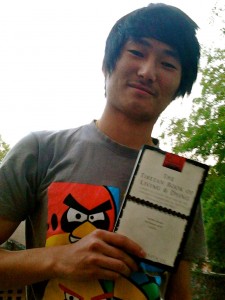 Kyipchu Kapz writes: “I was in the eleventh grade when I came to know about this book. It so happened that I took part in a live calling show, a radio program, and I was asked about my likes and dislikes. Read More
Kyipchu Kapz writes: “I was in the eleventh grade when I came to know about this book. It so happened that I took part in a live calling show, a radio program, and I was asked about my likes and dislikes. Read More
Generating the Heart of the Enlightened Mind
[W]hen you meditate deeply on compassion, a realization dawns in you that the only way for you to be of complete help to other beings is for you to gain enlightenment. From that a strong sense of determination and universal responsibility is born, and the compassionate wish arises in you at that moment to attain enlightenment for the benefit of all others.
This compassionate wish is called Bodhichitta in Sanskrit; bodhi means our enlightened essence, and chitta means heart. So we could translate it as “the heart of our enlightened mind.” To awaken and develop the heart of the enlightened mind is to ripen steadily the seed of our buddha nature, that seed that in the end, when our practice of compassion has become perfect and all-embracing, will flower majestically into buddhahood. Bodhichitta, then, is the spring and source and root of the entire spiritual path.
–Chapter 12 of The Tibetan Book of Living and Dying
In this beautiful short teaching on compassion and bodhichitta, Sogyal Rinpoche explains how arousing in our minds this altruistic attitude towards others’ happiness and well-being brings us great benefit, freeing us of negative emotions and engendering in us ‘an enlightened courage’, the ability to remain in a positive and happy state of mind and deal with whatever problems we may face.
For more teachings on compassion and bodhichitta, please visit our Videos page and the Teachings page of SogyalRinpoche.org.
